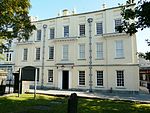User:Sionk/sandbox 4

There are many listed buildings in Llanelli, the largest town in Carmarthenshire, Wales. Llanelli's listed buildings include houses, churches and chapels, schools, commercial buildings, the town hall, a signal box and other industrial architecture.[1]
A listed building is one considered to be of special architectural, historical or cultural significance, and has restrictions on amendments or demolition. Buildings are listed as either Grade I, II* and II buildings lists, with the Grade I being the most important.[2]
Key[edit]
| Grade | Criteria[3] |
|---|---|
| Grade I | Buildings of exceptional, usually national, interest (generally the top 2%). |
| Grade II* | Particularly important buildings of more than special interest. |
| Grade II | Buildings of special interest, which warrant every effort being made to preserve them. |
Grade I and II* listed buildings[edit]
| Name | Photograph | Grade | Date | Location | Description |
|---|---|---|---|---|---|
| Llanelly House, Bridge Street |

|
I | 1714 | Town centre 51°41′00″N 4°09′41″W / 51.6834°N 4.1614°W |
A townhouse built for Sir Thomas Stepney and later bought by local industrialist, William Chambers, in 1825. Described as "the most outstanding domestic building of its early Georgian type to survive in South Wales". Later 19th-century shop front added.[4] The house opened to the public in 2013 after a 10 year restoration.[5] |
| No 20 Vaughan Street | 
|
I | 1714 | Town centre 51°41′00″N 4°09′41″W / 51.68333°N 4.16150°W |
A former rear wing of Llanelly House. Contains a large fireplace.[6] |
| No 22 Vaughan Street | 
|
I | 1714 | Town centre 51°41′00″N 4°09′41″W / 51.68330°N 4.16149°W |
A former rear wing of Llanelly House.[7] |
| No 24 Vaughan Street | 
|
I | 1714 | Town centre 51°41′00″N 4°09′41″W / 51.68327°N 4.16148°W |
A former rear wing of Llanelly House.[8] |
| Church of St Ellyw, Bridge Street | 
|
II* | 1400s | Town centre 51°41′02″N 4°09′40″W / 51.68375°N 4.16103°W |
Llanelli's parish church, with a tower possibly dating to the 1400s. The remainder of the church dates from 1905-06.[9] |
| Tabernacle Chapel, Coleshill Terrace | 
|
II* | 1873 | Town centre 51°40′57″N 4°09′49″W / 51.68241°N 4.16373°W |
By John Humphreys of Morriston. Described as "probably the most elaborate chapel in Llanelli", the forecourt and railings are also listed.[10] |
| Tinhouse of Old Castle Tinplate Works | 
|
II* | 1913 | Tyisha 51°40′46″N 4°10′20″W / 51.67955°N 4.17217°W |
A surviving tinplate works from 1905-1913, with rubble walls and an asbestos roof. It is a rare example of one with its original tinning bays.[11] |
Grade II listed buildings[edit]
According to the British Listed Buildings website there are 44 buildings in Penarth listed as Grade II, in addition to a bridge, a cenotaph, a pillar box and five telephone boxes. These include:
| Name | Photograph | Grade | Date | Location | Function | Description |
|---|---|---|---|---|---|---|
| Llanelli West Signal Box | 
|
II | 1877 | Tyisha 51°40′27″N 4°09′48″W / 51.67428°N 4.16342°W |
Signal Box | Built on the South Wales Railway line, Llanelli West is the last surviving example of five Type 2 signal boxes in the area. Control equipment replaced in 1973.[12] |
| No 8, Bridge Street | 
|
II | 1850c | Town centre 51°40′54″N 4°09′52″W / 51.68178°N 4.16450°W |
Shop building | Probably mid 19th century, adjoining the Grade I Llanelly House and originally part of that building. The ground floor comprises 2 large shop fronts, the right hand side one including original detailing.[13] |
| Town Hall, Church Street | 
|
II | 1896 | Town centre 51°40′54″N 4°09′52″W / 51.68178°N 4.16450°W |
Town Hall | By Williams Griffiths of Llanelli and built between 1894-6 in an Italianate style. Dated 1895 below the east clock of the tower. Council chamber altered considerably in 1970.[14] |
See also[edit]
References[edit]
- ^ "Terraced homes, a bandstand, railings and other Llanelli structures that can never be knocked down". Wales Online. 10 October 2020. Retrieved 2 March 2024.
- ^ "Understanding listing". Cadw. Retrieved 2 March 2024.
- ^ Listed Buildings in Wales: What is Listing? (PDF) (third ed.), Cadw, 2005, p. 6, retrieved 19 March 2013
- ^ "Llanelly House". British Listed Buildings. Retrieved 2 March 2024.
- ^ "Grade I-listed Llanelly House restored after 10 years". BBC. 5 November 2013. Retrieved 2 March 2024.
- ^ "20 Vaughan St / Bridge St". British Listed Buildings. Retrieved 2 March 2024.
- ^ "22 Vaughan St / Bridge St". British Listed Buildings. Retrieved 2 March 2024.
- ^ "24 Vaughan St / Bridge St". British Listed Buildings. Retrieved 2 March 2024.
- ^ "Parish Church of St. Ellyw". British Listed Buildings. Retrieved 2 March 2024.
- ^ "Tabernacle Chapel including forecourt Railings". British Listed Buildings. Retrieved 2 March 2024.
- ^ "Tinhouse, Old Castle Tinplate Works". British Listed Buildings. Retrieved 2 March 2024.
- ^ "Llanelli West Signal Boxh". British Listed Buildings. Retrieved 2 March 2024.
- ^ "NO.8 Bridge Street, Dyfed, 11898". British Listed Buildings. Retrieved 2 March 2024.
- ^ "The Town Hall". British Listed Buildings. Retrieved 2 March 2024.
Sources[edit]
- Listed Buildings in Llanelli, Carmarthenshire, BritishListedBuildings.co.uk
- Royal Commission on the Ancient and Historical Monuments of Wales (RCAHMW) website listings
